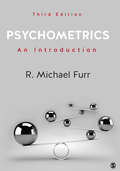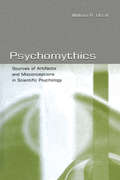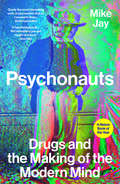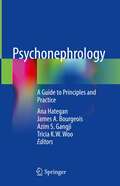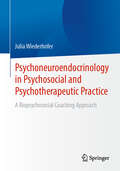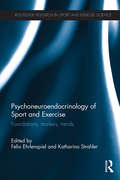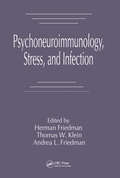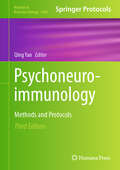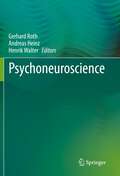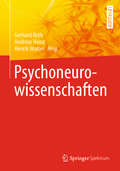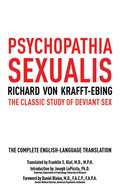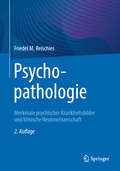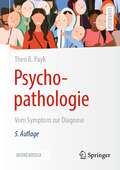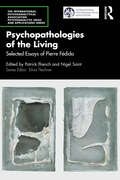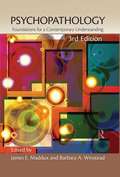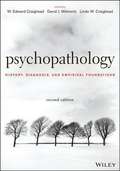- Table View
- List View
Psychometrics: An Introduction (Sage Library In Social And Personality Psychology Methods Ser.)
by R. Michael FurrUsing a meaning-based approach that emphasizes the “why” over the “how to,” Psychometrics: An Introduction provides thorough coverage of fundamental issues in psychological measurement. Author R. Michael Furr discusses traditional psychometric perspectives and issues including reliability, validity, dimensionality, test bias, and response bias as well as advanced procedures and perspectives including item response theory and generalizability theory. The substantially updated Third Edition includes broader and more in-depth coverage with new references, a glossary summarizing over 200 key terms, and expanded suggested readings consisting of highly relevant papers to enhance the book’s overall accessibility, scope, and usability.
Psychomythics: Sources of Artifacts and Misconceptions in Scientific Psychology
by William R. UttalPsychology deals with the most complex subject matter of any science. As such, it is subject to misunderstandings, artifacts, and just simple errors of data, logic, and interpretation. This book teases out the details of some of the sources of these errors. It considers errors in psychological data and theories that arise from confusing endogenous and exogenous causal forces in perceptual research, misinterpreting the effects of inevitable natural laws as psychological phenomena, improper application of statistics and measurement, and flawed assumptions. Examples of each of these sources of error are presented and discussed. Finally, the book concludes that a return to a revitalized kind of behaviorism is preferred, rather than continuing on the current cognitive path.
Psychonauts: Drugs and the Making of the Modern Mind
by Mike JayA provocative and original history of the scientists and writers, artists and philosophers who took drugs to explore the hidden regions of the mind A New Yorker Best of the Week Pick “Jay is a leading expert on the history of Western drug use, and Psychonauts is the latest in a series of excellent studies in which he has investigated the roots of a kind of psychoactive exploration that we tend to associate with the nineteen-fifties and sixties.”—Clare Bucknell, New Yorker “Captivating. . . . A welcome reconsideration of the role drugs play in life, medicine, and science.”—Publishers Weekly Until the twentieth century, scientists investigating the effects of drugs on the mind did so by experimenting on themselves. Vivid descriptions of drug experiences sparked insights across the mind sciences, pharmacology, medicine, and philosophy. Accounts in journals and literary fiction inspired a fascinated public to make their own experiments—in scientific demonstrations, on exotic travels, at literary salons, and in occult rituals. But after 1900 drugs were increasingly viewed as a social problem, and the long tradition of self-experimentation began to disappear. From Sigmund Freud’s experiments with cocaine to William James’s epiphany on nitrous oxide, Mike Jay brilliantly recovers a lost intellectual tradition of drug-taking that fed the birth of psychology, the discovery of the unconscious, and the emergence of modernism. Today, as we embrace novel cognitive enhancers and psychedelics, the experiments of the original psychonauts reveal the deep influence of mind-altering drugs on Western science, philosophy, and culture.
Psychonephrology: A Guide to Principles and Practice
by James A. Bourgeois Ana Hategan Azim S. Gangji Tricia K. W. WooThe book focuses on pharmacological and non-pharmacological approaches of psychiatric syndromes that commonly occur in patients with kidney disease. It specifically reviews principles of psychotherapy and psychopharmacology with an emphasis on organ impairment and drug-drug interactions specific to nephrology. This book also covers issues with medication nonadherence in patients with chronic kidney disease and psychiatric comorbidity, as well as the associated issues in dialysis and renal transplantation. Additionally, chapters cover various other topics addressing an active stance towards health promotion in chronically ill patients, including the critical role of the diet and physical activity. Such advice is often complex and changing depending on the stage of chronic kidney disease and the individual needs of the patient. Written by specialists in the field, Psychonephrology: A Guide to Principles and Practice serves as a valuable reference and teaching tool that provides an opportunity for learning across a rapidly evolving medical field.
Psychoneuroendocrinology in Psychosocial and Psychotherapeutic Practice: A Biopsychosocial Coaching Approach
by Julia WiederhoferWhat are hormones, and what significance do they have for the psyche and our behavior? Do hormones influence our psyche and behavior? Can our behavior influence our hormones? Is there a connection between hormones and mental disorders? This book explores the interplay between the neurobiological foundations of psychological experiences and behavior, endocrine processes, and psychosocial environmental influences. It presents the foundational research of both the scientific disciplines of endocrinology and psychoneuroendocrinology in a way that is accessible to readers without medical or neurobiological backgrounds. This book demonstrates for the first time how these interdisciplinary insights can be implemented into a biopsychosocial coaching approach, which serves both to maintain and promote mental health. It is a coaching approach suitable for both psychosocial counseling and psychotherapeutic practice.
Psychoneuroendocrinology of Sport and Exercise: Foundations, Markers, Trends (Routledge Research in Sport and Exercise Science)
by Felix Ehrlenspiel Katharina StrahlerPsychoneuroendocrinology is the study of the interaction between hormones, the brain and human behaviour. This is the first book to examine psychoneuroendocrinology in the context of sport and exercise, offering a comprehensive review of current research and assessment techniques and highlighting directions for future research. The book explores the links between hormones and behaviour, and draws important conclusions for how their study will aid in the understanding of the bidirectional link between sport and behaviour, central to the psychology of sport and exercise. It presents the key hormones that underpin behaviour in a sporting context, including the description of their physiologic mechanisms and behavioural effects. The book reports benchmark standards for the assessment and analysis of hormonal influences of behaviour in sport, and examines practical issues and contexts such as emotional state, overtraining and stress. Psychoneuroendocrinology in Sport and Exercise is a breakthrough text that will be of interest to all advanced students and researchers working in the psychology and physiology of sport and exercise.
Psychoneuroendokrinologie in der psychosozialen und psychotherapeutischen Praxis: Ein biopsychosozialer Coachingansatz
by Julia WiederhoferWas sind Hormone und welche Bedeutung haben sie für die Psyche bzw. unser Verhalten? Beeinflussen Hormone unsere Psyche bzw. unser Verhalten? Kann unser Verhalten unsere Hormone beeinflussen? Besteht ein Zusammenhang zwischen Hormonen und psychischen Störungen? In diesem Buch wird das Wechselspiel zwischen neurobiologischen Grundlagen psychischen Erlebens und Verhaltens, den endokrinen Vorgängen sowie psychosozialen Umwelteinflüssen gezeigt. Dabei wird die Grundlagenforschung, sowohl der wissenschaftlichen Disziplin Endokrinologie als auch der Psychoneuroendokrinologie dargestellt und so erläutert, dass auch Leserinnen ohne medizinische oder neurobiologische Vorkenntnisse diese komplexen Wissenschaften verstehen. Dieses Buch zeigt zum ersten Mal, wie diese interdisziplinären Erkenntnisse in einen biopsychosozialen Coachingansatz implementiert werden können, der sowohl zur Aufrechterhaltung als auch zur Förderung der psychischen Gesundheit dient. Ein Coachingansatz, der für die psychosoziale und für die psychotherapeutische Praxis geeignet ist.
Psychoneuroimmunology, Stress, and Infection
by Herman Friedman Thomas W. Klein Andrea L. FriedmanPsychoneuroimmunology is the emerging science devoted to studying the two-way relationship between the nervous and immune systems. Psychoneuroimmunology, Stress, and Infection highlights the latest information concerning microbial infections in both man and animals as related to stress and especially stress hormones.The volume focuses on psychoneuroimmunology as it impacts the immune system in general and also the relationship between neurological events which influence susceptibility and/or resistance to infectious agents such as bacteria, fungi and viruses, as well as parasites. Prominent researchers describe the involvement of the hypothalamus-pituitary-adrenal (HPA) axis on immunity as a function of the nervous system. The text discusses hormones such as prolactin and growth hormone and steroid induced susceptibility to infection and neuropeptides, including vasoactive intestinal peptide, and substance P. The effects of catacholamines on immunity and susceptibility to infection are also covered. This reference also details the involvement of immune cells in the synthesis of neuropeptides, including hormones and endorphins, their effect on the brain as well as the effects of interleukins and tumor necrosis factor on the central nervous system. The book concludes with an interesting look at the relationship between aging, psychoneuroimmunology, and infection. Although there is much new knowledge concerning the nature and mechanism of immune responses, including the mediators involved, Psychoneuroimmunology, Stress, and Infection also presents important discussions and reviews that are long overdue and provide a major contribution to the area of biomedical knowledge in general and psychoneuroimmunology in particular.
Psychoneuroimmunology: Methods and Protocols (Methods in Molecular Biology #2868)
by Qing YanThis fully-updated third edition provides systems-based methodologies and innovative technologies that can be used for solving complicated problems of complex systems. A wide range of theoretical and experimental approaches are introduced for practical applications, as the content explores the basic and novel concepts in psychoneuroimmunology (PNI), especially the relationships among stress, inflammation, and psychophysiological disorders, as well as various cutting-edge technologies and methods for PNI studies, including the utilizations of mouse models and vaccine models. As part of the Methods in Molecular Biology series, the chapters seek to provide a practical, state-of-the-art, and holistic view for the translation of PNI into better preventive and personalized medical practice. Authoritative and hands-on, Psychoneuroimmunology: Methods and Protocols, Third Edition will be of use to biomedical students and professionals at all levels.
Psychoneuroscience
by Martin LayThe textbook builds a bridge between the "neurosciences" (theoretical and experimental neurobiology, neurology) and the "psychosciences" (psychology, psychiatry, psychotherapy) and aims to help provide the other disciplines with the most important and scientifically validated knowledge in an understandable form. The question of how mental experience and brain processes relate to each other has long been considered mysterious. In this book you will learn, based on the latest scientific findings, that the two areas form an indissoluble unity, even if we experience and study them differently. We present this unity in concrete terms in psychological-neurobiological theory and psychiatric-psychotherapeutic practice. We treat the principles of neurobiological excitation and information processing, the structure and function of the limbic system, the development of the personality and the interaction of genetic-epigenetic factors and prenatal and postnatal environmental influences, which may be favourable or unfavourable. On this basis, the exemplary presentation of important mental disorders such as addictive disorders, schizophrenic disorders, affective disorders and anxiety disorders takes place. Finally, following in the footsteps of the eminent psychotherapist Klaus Grawe, the concept of "neuropsychotherapy" is introduced and it is shown why psychotherapy and neurobiology belong together and can enrich each other. Our psychoneuroscientific approach paints a picture of man that is not based on opposites, but on an integration of psyche, brain, behavior and experience.
Psychoneurowissenschaften
by Martin LayDas Lehrbuch schlägt eine Brücke zwischen den „Neurowissenschaften“ (theoretische und experimentelle Neurobiologie, Neurologie) und den „Psychowissenschaften“ (Psychologie, Psychiatrie, Psychotherapie) und will dabei helfen, den jeweils anderen Disziplinen die wichtigsten und wissenschaftlich gesicherten Kenntnisse in verständlicher Form zu liefern. Die Frage, wie sich psychisches Erleben und Gehirnvorgänge zueinander verhalten, galt lange als rätselhaft. In diesem Buch erfahren Sie aufgrund neuester wissenschaftlicher Erkenntnisse, dass beide Bereiche eine unauflösliche Einheit bilden, auch wenn wir sie unterschiedlich erfahren und untersuchen. Diese Einheit stellen wir in der psychologisch-neurobiologischen Theorie und der psychiatrisch-psychotherapeutischen Praxis konkret dar. Wir behandeln die Prinzipien der neurobiologischen Erregungs- und Informationsverarbeitung, Aufbau und Funktion des limbischen Systems, die Entwicklung der Persönlichkeit und der dabei stattfindenden günstig oder ungünstig verlaufenden Interaktion genetisch-epigenetischer Faktoren und vorgeburtlich sowie nachgeburtlich stattfindender Umwelteinflüssen. Auf dieser Grundlage erfolgt die beispielhafte Darstellung wichtiger psychischer Störungen wie Suchterkrankungen, schizophrene Störungen, affektive Störungen sowie Angststörungen. In der Nachfolge des bedeutenden Psychotherapeuten Klaus Grawe wird schließlich in das, Konzept der „Neuropsychotherapie“ eingeführt und gezeigt, warum Psychotherapie und Neurobiologie zusammengehören, und sich gegenseitig bereichern können. Unser psychoneurowissenschaftlicher Ansatz zeichnet ein Menschenbild, das nicht auf Gegensätzen, sondern einer Integration von Psyche, Gehirn, Verhalten und Erleben beruht.
Psychopath Free (Expanded Edition): Recovering from Emotionally Abusive Relationships With Narcissists, Sociopaths, and Other Toxic People
by Jackson MacKenzieFrom the author of Whole Again comes a significantly expanded edition of Psychopath Free—containing new chapters, updated content, and real survivor experiences—that will help you recover from emotionally abusive relationships with narcissists, sociopaths, and other toxic people.Have you ever been in a relationship with a psychopath? Chances are, even if you did, you would never know it. Psychopaths are cunning charmers and master manipulators, to the point where you start to accept the most extreme behaviors as normal...Even if it hurts you. All around us, every single day, human beings devoid of empathy are wreaking havoc and destroying lives in the coldest, most heartless ways imaginable. In constant pursuit of money, sex, influence, or simple entertainment, psychopaths will do whatever it takes to gain power over others. They hide behind a veil of normalcy, arranging their friends and partners like pawns in a game of chess. Using false praise and flattery to get what they want, they can lure any unsuspecting target into a relationship. Once hooked, their charming promises spin into mind games and psychological torture. Victims are left devastated and confused, unable to recognize—or even put into words—the nightmare that just took place. Written from the heart, Psychopath Free is the first guide for survivors written by a survivor, offering hope for healing and thriving after psychopathic abuse. Say goodbye to the chaos, self-doubt, and victimization. You are free.
Psychopathia Sexualis: The Classic Study of Deviant Sex
by Richard von Krafft-Ebing Joseph LopiccoloPreceding Freud's Three Contributions to the Theory of Sex by more than twenty years, Richard von Krafft-Ebing's Psychopathia Sexualis pioneered the psychological study of sexual behavior.<P><P> This classic nineteenth-century work on sexual aberration addressed such previously taboo subjects as bestiality, cunnilingus and fellatio, fetishism, incest, masochism, masturbation, nymphomania, and sadism, making it the first serious attempt to catalog and define such "deviations." For almost one hundred years, Psychopathia Sexualis stood as the world's most informative volume on the subject of sexual deviation. Arguably the most important precursor to Freud in the study of human sexuality, Krafft-Ebing introduced ideas and concepts that greatly influenced the works of Alfred Kinsey and Masters and Johnson. In his own time Krafft-Ebing was both praised and damned for this volume. Some psychiatrists denounced the work as an immoral apology for perversion and deviance, while others recognized the immense service the author had done for an unjustly neglected area of study. Although sometimes dated by the beliefs and state of knowledge of the time it was written, Psychopathia Sexualis is essential (and immensely entertaining) as one of the most important documents in humankind's modern effort to understand itself.
Psychopathologie: Merkmale psychischer Krankheitsbilder und klinische Neurowissenschaft
by Friedel M. ReischiesWie erklärt die Neurowissenschaft Bewusstseinsänderungen? Was passiert im Gehirn z.B. bei einem Angstzustand? Viele Menschen leiden irgendwann an Symptomen wie Antriebslosigkeit oder Bedrücktheit. Psychiatrische Krankheitsbilder sind psychopathologische Merkmalskomplexe, die eine genaue Beobachtung und Wertung benötigen. Hier finden Leser die Psychopathologie mit ihren neurowissenschaftlichen Grundlagen umfassend dargestellt. Systematisch und übersichtlich sind alle Symptome beschrieben. Fallbeispiele vertiefen Beobachtung und klinische Erfahrung. Jedem Kapitel folgen Definitionen, klinische Gesichtspunkte und Diagnostik. Neurowissenschaftliche Modelle sind für jede Merkmalsgruppe und spezielle Aspekte veranschaulicht. Das Buch richtet sich an Psychiater und andere Berufsgruppen aus der psychosozialen Versorgung sowie interessierte Studenten. Es hilft Untersuchenden, Patienten eine verständliche und zutreffende Erklärung ihres Symptoms zu bieten. Für die Neuauflage wurde das Werk komplett überarbeitet, aktualisiert sowie um neueste Forschungsergebnisse zu spannenden aktuellen Themen, wie z.B. zu Halluzinationen und Deep Learning ergänzt.
Psychopathologie: Vom Symptom zur Diagnose
by Theo R. PaykPsychopathologie ist die Lehre von den psychischen Störungen auf Symptom- und Syndromebene. Erst das exakte Erkennen und Beschreiben der Krankheitszeichen ermöglicht die korrekte Diagnose. In diesem Lehrbuch wird das hierzu nötige Wissen verständlich und anschaulich vermittelt. Es gliedert die Symptome nach Funktionsbereichen (Pathologie des Bewusstseins, der Wahrnehmung, der Gefühle u.a.), erklärt komplexere Syndrome, die sich auf verschiedenen Ebenen des Erlebens, Verhaltens und Handelns äußern und liefert aktuelle Erkenntnisse, notwendiges Kernwissen sowie historische Bezüge. Alles ist lernfreundlich und praxisnah aufbereitet: neben kurzen Beschreibungen der Untersuchungsmethoden zur Erfassung der Symptome bietet das Buch praktische Zusammenfassungen und anschauliche Abbildungen. "Psychopathologie": Symptome erkennen, Symptome verstehen.
Psychopathologies of the Living: Selected Essays of Pierre Fédida (The International Psychoanalytical Association Psychoanalytic Ideas and Applications Series)
by Ffrench PatrickPsychopathologies of the Living makes the work of the French psychoanalyst Pierre Fédida (1934–2002) available in English for the first time.Patrick ffrench and Nigel Saint present key essays selected from Fédida’s extensive oeuvre. The book directs attention to two salient dimensions of Fédida’s writing: his attention to the pathologies of the body, considered as both a psychic and somatic entity, and his insistence on the relevance of psychoanalytic thought to the sciences of life. The chapters included in this collection detail Fédida’s creative use of aesthetic sources in his psychoanalytic work, his distinctive and creative manipulation and revision of central psychoanalytic concepts and his precise attention to the texts of Freud, Ferenczi and Winnicott, among others. This selection of Fédida’s essays also shows his avoidance of thematisation or explicit theorisation; for Fédida the theory of psychoanalysis must arise out of the specific interplay of language and the ‘space of the session’.Psychopathologies of the Living will be of great interest to psychoanalysts in practice and in training and to academics and scholars of philosophy, aesthetics and literary studies.
Psychopathology
by Barbara A. Winstead James E. MadduxThis is the most up-to-date text about the etiology and treatment of the most important psychological disorders. Intended for first-year graduate students in clinical and counseling psychology, the third edition of Psychopathology continues to focus on research and empirically supported information while also challenging students to think critically. The first part of the book is devoted to the issues, ideas, and concepts in psychopathology. These chapters give students a set of conceptual tools that will help them read more thoroughly and critically the second half of the book, which focuses on specific disorders. Each chapter in this section provides a definition, description, and brief history of the disorder it discusses, and outlines theory and research on etiology and empirically supported treatments. The length, organization, content, and level and style of writing are consistently tailored to the audience, and the disorders discussed are the ones most frequently encountered by students in their training and subsequent clinical careers. A new section addresses child and adolescent disorders, while updated sections include dimensional approaches, the biological bases of psychopathology, learning theories, developmental psychopathology, dissociative disorders, mental health and aging, and mood disorders. This valuable teaching tool is not only appropriate for students, but also professionals, who will continue to refer to it as a reference.
Psychopathology
by David J. Miklowitz W. Edward Craighead Linda W. CraigheadFully revised to incorporate DSM-5 criteria and informed by the most current research in its discussions of diagnosis and treatmentNow in a second edition, Psychopathology: History, Diagnosis, and Empirical Foundations thoroughly explores psychopathology with contributions from leading scholars in psycho-pathology. The Second Edition offers an overview of various topics in the context of major changes included in the DSM-5 .With new chapters on contextual factors affecting diagnoses and non-alcohol substance abuse, Psychopathology, Second Edition covers the history, theory, and assessment of anxiety disorders, posttraumatic stress disorder, mood disorders, schizophrenia, the psychotic spectrum disorders, eating disorders, borderline personality disorder, alcohol use disorders, psychopathy, sexual dysfunction, and sleep disorders. In addition, each chapter of the Second Edition contains:A description of the disorder, including brief history, case example, and epidemiological findingsEmpirical foundations of each disorder, including findings regarding neurobiological, behavioral, cognitive, and emotional factorsAssessment of each disorder, including interviews, self-reports, neurobiological assessment, and clinical rating scalesBrief description and evaluation of the current interventions for each disorderSummary and future directionsPractical and thorough, this text is an essential reference for all mental health professionals and a solid introduction for students in psychopathology courses.
Psychopathology
by Thomas F. Oltmanns Louis G. CastonguayThis authoritative text gives students and practicing psychotherapists a rich understanding of the connections between psychopathology research and clinical practice. Chapters thoroughly describe the etiology, symptoms and clinical features, course, epidemiology, and associated comorbidities of prevalent psychological disorders. Changes in diagnostic criteria in DSM-5 are addressed, where applicable. What sets this tightly edited volume apart are insightful discussions of how current empirical findings can inform assessment, case formulation, the therapeutic relationship, and intervention strategies (regardless of theoretical orientation). Each chapter is written collaboratively by leading psychopathology and psychotherapy researchers.
Psychopathology
by William J. RayIn Psychopathology, Fourth Edition, best-selling author William J. Ray brings together current perspectives concerning the manner in which the human mind, behavior, and experience can be understood. In addition to the traditional psychological literature, this book draws from work in the cognitive and affective neurosciences, epidemiology, ethology, and genetics. Ray focuses on unifying and integrating the biopsychosocial understandings of human behavior within a broader consideration of human culture and language as it applies to psychopathology. This title is accompanied by a complete teaching and learning package. Contact your Sage representative to request a demo. Learning Platform / Courseware Sage Vantage is an intuitive learning platform that integrates quality Sage textbook content with assignable multimedia activities and auto-graded assessments to drive student engagement and ensure accountability. Unparalleled in its ease of use and built for dynamic teaching and learning, Vantage offers customizable LMS integration and best-in-class support. It′s a learning platform you, and your students, will actually love. Learn more. Assignable Video with Assessment Assignable video (available in Sage Vantage) is tied to learning objectives and curated exclusively for this text to bring concepts to life. Watch a guided tour to learn more. LMS Cartridge: Import this title’s instructor resources into your school’s learning management system (LMS) and save time. Don′t use an LMS? You can still access all of the same online resources for this title via the password-protected Instructor Resource Site. Learn more.
Psychopathology
by William J. RayIn Psychopathology, Fourth Edition, best-selling author William J. Ray brings together current perspectives concerning the manner in which the human mind, behavior, and experience can be understood. In addition to the traditional psychological literature, this book draws from work in the cognitive and affective neurosciences, epidemiology, ethology, and genetics. Ray focuses on unifying and integrating the biopsychosocial understandings of human behavior within a broader consideration of human culture and language as it applies to psychopathology. This title is accompanied by a complete teaching and learning package. Contact your Sage representative to request a demo. Learning Platform / Courseware Sage Vantage is an intuitive learning platform that integrates quality Sage textbook content with assignable multimedia activities and auto-graded assessments to drive student engagement and ensure accountability. Unparalleled in its ease of use and built for dynamic teaching and learning, Vantage offers customizable LMS integration and best-in-class support. It′s a learning platform you, and your students, will actually love. Learn more. Assignable Video with Assessment Assignable video (available in Sage Vantage) is tied to learning objectives and curated exclusively for this text to bring concepts to life. Watch a guided tour to learn more. LMS Cartridge: Import this title’s instructor resources into your school’s learning management system (LMS) and save time. Don′t use an LMS? You can still access all of the same online resources for this title via the password-protected Instructor Resource Site. Learn more.
Psychopathology (Routledge Modular Psychology)
by John D. Stirling Jonathan S.E. HellewellPsychopathology is a psychologically based account of the major mental illnesses, including schizophrenia, personality disorders, anxiety and mood disorders as well as eating disorders.
Psychopathology (Routledge Modular Psychology)
by John Stirling Jonathan HellewellPsychopathology is a psychologically based account of the major mental illnesses, including schizophrenia, personality disorders, anxiety and mood disorders as well as eating disorders.
Psychopathology and Philosophy of Mind: What Mental Disorders Can Tell Us About Our Minds
by Valentina Cardella; Amelia GangemiThis book explores how the human mind works through the lens of psychological disorders, challenging many existing theoretical constructs, especially in the fields of psychology, psychiatry and philosophy of mind. Drawing on the expertise of leading academics, the book discusses how psychopathology can be used to inform our understanding of the human mind. The book argues that studying mental disorders can deepen the understanding of psychological mechanisms such as reasoning, emotions, and beliefs alongside fundamental philosophical questions, including the nature of the self, the universal aspects of morality, and the role of rationality and normativity in human nature. By crossing different domains, this book offers a fresh perspective on the human mind based on the dialogue between philosophy, cognitive science and clinical psychology. Mental disorders discussed include schizophrenia, anxiety disorders, major depression, obsessive-compulsive disorder, post-traumatic stress disorder and paranoia. This book caters to the increasing interest in interdisciplinary approach to solving some of the problems in psychopathology. Since this book treats psychological engagement with empirically informed philosophy of mind, this book is essential reading for students and researchers of cognitive psychology, clinical psychology, and philosophy, as well as being of interest to clinicians and psychiatrists.
Psychopathology and Psychiatry
by Ivan P. PavlovPavlov’s fundamental theory of higher nervous activity concerns the adaptation to changing external environments of organisms such as dogs, apes, and humans. In the 1920s, Pavlov and his disciples used laboratory experimentation to study the etiology and therapy of neuroses In human beings and other species. Later, In the 1930s, Pavlov devoted much time and effort to the systematic study of psychopathology In clinical settings. Psychopathology and Psychiatry is Pavlov’s little-known series of descriptions of these experiments and findings. Pavlov used two fundamental approaches In the study of neuroses and psychoses: the conditioned salivary reflex method, with dogs as subjects; and the observation of neurotic and psychotic behavior In humans. Pavlov was primarily Interested In how the cortex worked to facilitate the orgaftilsm's adaptation to the external environment. The conditioned reflex findings were explained In terms of hypothetical physiological processes. Pavlov was certain that dogs’ Inability to adapt flexibly was the result of conflicts and traumatic experiences. Soon thereafter, he linked these discoveries to actual human cases of neuroses and psychoses. These are covered In this volume. In a new introduction to this classic text, George Windholz traces Pavlov’s scholarly and scientific life, highlighting his various studies and results under stressful political and pedagogical conditions. Psychopathology and Psychiatry continues to be a highly significant work of scientific study. Psychologists, psychiatrists, and behavioral researchers of all professional persuasions will find this work to be essential reading.
